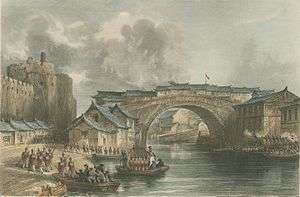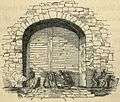Battle of Chinkiang
| Battle of Chinkiang | |||||||
|---|---|---|---|---|---|---|---|
| Part of the First Opium War | |||||||
 British troops at the western gate of the city | |||||||
| |||||||
| Belligerents | |||||||
|
| |||||||
| Commanders and leaders | |||||||
| Hugh Gough | Hailing[1] | ||||||
| Strength | |||||||
| 6,907 troops[2] | 3,000–4,000 troops (est.)[3] | ||||||
| Casualties and losses | |||||||
|
Land:[4] 34 killed 107 wounded 3 missing Naval:[5] 3 killed 21 wounded | 1,000 killed or wounded[6] | ||||||
The Battle of Chinkiang was fought between British and Chinese forces in Chinkiang (Zhenjiang), Jiangsu province, China, on 21 July 1842 during the First Opium War. It was the last major battle of the war. The Chinese force consisted of a garrison of Manchu and Mongol Bannermen.[7] In command of the British forces was Sir Hugh Gough. Leading one brigade was future British field marshal Sir Colin Campbell.[8] The British capture of this stronghold allowed them to proceed to Nanking. Fought near the confluence of the Grand Canal and Yangtze River, the battle effectively blocked operation of the Caoyun system, a transport network vital for the movement of grain throughout the empire. As a result, the Daoguang Emperor decided to sue for peace and agreed to sign the Treaty of Nanking, which brought hostilities to an end. Mass suicide was committed by the Manchu Bannermen who were defending the city.[9]
Gallery
-

Map of the battle
-

Rallying of the Tartar troops
-

Engagement in Chinkiang
-

Escalade in Chinkiang
-

Blowing open the gates of the city
-

Battle memorial at St. George's Cathedral, Madras
Notes
- ↑ Waley 1958, p. 197
- ↑ Rait 1903, p. 272
- ↑ Bingham 1843, p. 353
- ↑ Bulletins 1842, pp. 780, 787
- ↑ Hall & Bernard 1844, pp. 417–418
- ↑ The Chinese Repository, vol. 11, p. 513
- ↑ Elliott, Mark (June 1990). "Bannerman and Townsman: Ethnic Tension in Nineteenth-Century Jiangnan". Late Imperial China 11 (1): 36–74.
- ↑ Greenwood 2015, p. 496
- ↑ John Makeham (2008). China: The World's Oldest Living Civilization Revealed. Thames & Hudson. p. 331. ISBN 978-0-500-25142-3.
References
- Bulletins of State Intelligence. Westminster: F. Watts. 1842.
- The Chinese Repository. Volume 11. Canton. 1842.
- Bingham, J. Elliot (1843). Narrative of the Expedition to China, from the Commencement of the War to Its Termination in 1842 (2nd ed.). Volume 2. London: Henry Colburn.
- Greenwood, Adrian (2015). Victoria's Scottish Lion: The Life of Colin Campbell, Lord Clyde. UK: History Press. ISBN 0-75095-685-2.
- Hall, William Hutcheon Hall; Bernard, William Dallas (1844). Narrative of the Voyages and Services of the Nemesis, from 1840 to 1843. Volume 2. London: Henry Colburn.
- Rait, Robert S. (1903). The Life and Campaigns of Hugh, First Viscount Gough, Field-Marshal. Volume 1. Westminster: Archibald Constable.
- Waley, Arthur (1958). The Opium War Through Chinese Eyes. Woking, Surrey: George Allen & Unwin. ISBN 0-04-951012-6.